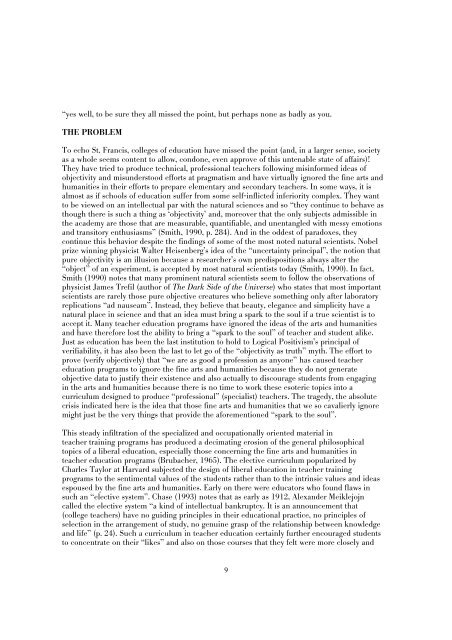SECTION 1 - via - School of Visual Arts
SECTION 1 - via - School of Visual Arts
SECTION 1 - via - School of Visual Arts
Create successful ePaper yourself
Turn your PDF publications into a flip-book with our unique Google optimized e-Paper software.
“yes well, to be sure they all missed the point, but perhaps none as badly as you.<br />
THE PROBLEM<br />
To echo St. Francis, colleges <strong>of</strong> education have missed the point (and, in a larger sense, society<br />
as a whole seems content to allow, condone, even approve <strong>of</strong> this untenable state <strong>of</strong> affairs)!<br />
They have tried to produce technical, pr<strong>of</strong>essional teachers following misinformed ideas <strong>of</strong><br />
objectivity and misunderstood efforts at pragmatism and have virtually ignored the fine arts and<br />
humanities in their efforts to prepare elementary and secondary teachers. In some ways, it is<br />
almost as if schools <strong>of</strong> education suffer from some self-inflicted inferiority complex. They want<br />
to be viewed on an intellectual par with the natural sciences and so “they continue to behave as<br />
though there is such a thing as ‘objectivity’ and, moreover that the only subjects admissible in<br />
the academy are those that are measurable, quantifiable, and unentangled with messy emotions<br />
and transitory enthusiasms” (Smith, 1990, p. 284). And in the oddest <strong>of</strong> paradoxes, they<br />
continue this behavior despite the findings <strong>of</strong> some <strong>of</strong> the most noted natural scientists. Nobel<br />
prize winning physicist Walter Heisenberg’s idea <strong>of</strong> the “uncertainty principal”, the notion that<br />
pure objectivity is an illusion because a researcher’s own predispositions always alter the<br />
“object” <strong>of</strong> an experiment, is accepted by most natural scientists today (Smith, 1990). In fact,<br />
Smith (1990) notes that many prominent natural scientists seem to follow the observations <strong>of</strong><br />
physicist James Trefil (author <strong>of</strong> The Dark Side <strong>of</strong> the Universe) who states that most important<br />
scientists are rarely those pure objective creatures who believe something only after laboratory<br />
replications “ad nauseam”. Instead, they believe that beauty, elegance and simplicity have a<br />
natural place in science and that an idea must bring a spark to the soul if a true scientist is to<br />
accept it. Many teacher education programs have ignored the ideas <strong>of</strong> the arts and humanities<br />
and have therefore lost the ability to bring a “spark to the soul” <strong>of</strong> teacher and student alike.<br />
Just as education has been the last institution to hold to Logical Positivism’s principal <strong>of</strong><br />
verifiability, it has also been the last to let go <strong>of</strong> the “objectivity as truth” myth. The effort to<br />
prove (verify objectively) that “we are as good a pr<strong>of</strong>ession as anyone” has caused teacher<br />
education programs to ignore the fine arts and humanities because they do not generate<br />
objective data to justify their existence and also actually to discourage students from engaging<br />
in the arts and humanities because there is no time to work these esoteric topics into a<br />
curriculum designed to produce “pr<strong>of</strong>essional” (specialist) teachers. The tragedy, the absolute<br />
crisis indicated here is the idea that those fine arts and humanities that we so cavalierly ignore<br />
might just be the very things that provide the aforementioned “spark to the soul”.<br />
This steady infiltration <strong>of</strong> the specialized and occupationally oriented material in<br />
teacher training programs has produced a decimating erosion <strong>of</strong> the general philosophical<br />
topics <strong>of</strong> a liberal education, especially those concerning the fine arts and humanities in<br />
teacher education programs (Brubacher, 1965). The elective curriculum popularized by<br />
Charles Taylor at Harvard subjected the design <strong>of</strong> liberal education in teacher training<br />
programs to the sentimental values <strong>of</strong> the students rather than to the intrinsic values and ideas<br />
espoused by the fine arts and humanities. Early on there were educators who found flaws in<br />
such an “elective system”. Chase (1993) notes that as early as 1912, Alexander Meiklejojn<br />
called the elective system “a kind <strong>of</strong> intellectual bankruptcy. It is an announcement that<br />
(college teachers) have no guiding principles in their educational practice, no principles <strong>of</strong><br />
selection in the arrangement <strong>of</strong> study, no genuine grasp <strong>of</strong> the relationship between knowledge<br />
and life” (p. 24). Such a curriculum in teacher education certainly further encouraged students<br />
to concentrate on their “likes” and also on those courses that they felt were more closely and<br />
9








